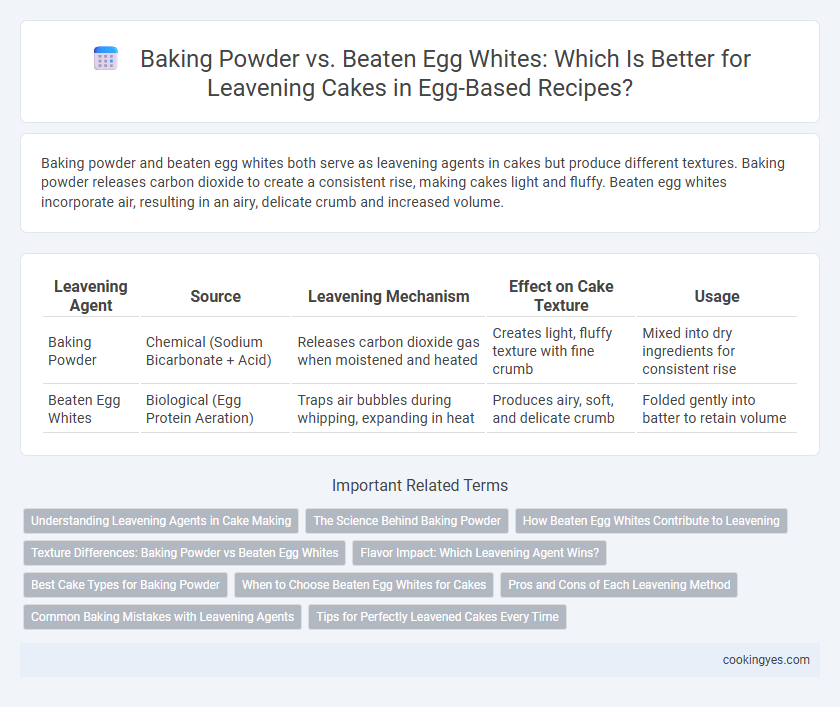Baking powder and beaten egg whites both serve as leavening agents in cakes but produce different textures. Baking powder releases carbon dioxide to create a consistent rise, making cakes light and fluffy. Beaten egg whites incorporate air, resulting in an airy, delicate crumb and increased volume.
Table of Comparison
| Leavening Agent | Source | Leavening Mechanism | Effect on Cake Texture | Usage |
|---|---|---|---|---|
| Baking Powder | Chemical (Sodium Bicarbonate + Acid) | Releases carbon dioxide gas when moistened and heated | Creates light, fluffy texture with fine crumb | Mixed into dry ingredients for consistent rise |
| Beaten Egg Whites | Biological (Egg Protein Aeration) | Traps air bubbles during whipping, expanding in heat | Produces airy, soft, and delicate crumb | Folded gently into batter to retain volume |
Understanding Leavening Agents in Cake Making
Baking powder, a chemical leavening agent, releases carbon dioxide bubbles during baking, causing cakes to rise uniformly and quickly. Beaten egg whites incorporate air physically, creating a foam that adds volume and a light, airy texture to the cake. Understanding the differences between these leavening methods helps bakers choose the right technique for desired cake density and crumb structure.
The Science Behind Baking Powder
Baking powder contains a combination of acid and alkaline components that react with moisture and heat to produce carbon dioxide gas, creating bubbles that cause the cake batter to rise. This chemical leavening process provides consistent and controlled expansion, resulting in a uniform crumb structure in cakes. Unlike beaten egg whites that rely on trapped air and protein stabilization, baking powder offers a reliable, quicker leavening method independent of egg quality or technique.
How Beaten Egg Whites Contribute to Leavening
Beaten egg whites incorporate air into the batter, creating a foam that traps gas bubbles and expands during baking, resulting in a lighter, fluffier cake texture. Their protein structure stabilizes the foam, providing lift without the chemical reaction associated with baking powder. This natural leavening method enhances volume and tenderness while maintaining a delicate crumb in cakes.
Texture Differences: Baking Powder vs Beaten Egg Whites
Baking powder creates a consistent and uniform rise by releasing carbon dioxide during baking, resulting in a tender, fine crumb texture. Beaten egg whites incorporate air bubbles that expand in the oven, producing a lighter, airier, and more delicate structure with increased volume. The choice between baking powder and beaten egg whites significantly influences the cake's density and mouthfeel, with egg whites offering a fluffier, more ethereal texture compared to the slightly denser crumb from baking powder.
Flavor Impact: Which Leavening Agent Wins?
Baking powder produces a neutral taste, allowing the cake's original flavors to shine without alteration. Beaten egg whites contribute a subtle richness and airy texture that can enhance the overall flavor complexity and mouthfeel. For flavor impact, beaten egg whites often win by adding depth and natural sweetness, while baking powder excels in simplicity and consistency.
Best Cake Types for Baking Powder
Baking powder is ideal for dense cake types such as pound cakes and butter cakes, as it provides consistent chemical leavening that produces a tender crumb and uniform rise. It works efficiently in recipes with lower egg content or no eggs, ensuring quicker and more reliable aeration compared to beaten egg whites. Cakes like sponge or chiffon, which rely on egg whites for lightness, differ fundamentally from baking powder-leavened cakes that emphasize moist texture and fine grain.
When to Choose Beaten Egg Whites for Cakes
Beaten egg whites are ideal for light, airy cakes like angel food or chiffon, where maximizing volume and delicate texture is essential. They provide natural leavening by trapping air during whisking, creating a stable foam that expands during baking without added chemical agents. Use beaten egg whites when a tender crumb and subtle rise are preferred over the more pronounced lift from baking powder.
Pros and Cons of Each Leavening Method
Baking powder provides consistent and reliable leavening by releasing carbon dioxide when moistened and heated, making it ideal for quick and easy cake preparation, though it can sometimes produce a slightly chemical taste. Beaten egg whites create a natural, airy texture by incorporating air and providing structure, resulting in a lighter and fluffier cake, but this method requires precise technique and timing to avoid collapse. Choosing between these methods depends on the desired texture, flavor profile, and the baker's skill level in whipping and folding egg whites.
Common Baking Mistakes with Leavening Agents
Using baking powder and beaten egg whites as leavening agents requires precise techniques to avoid common mistakes such as overmixing, which can collapse the batter's structure and reduce cake volume. Baking powder's chemical reaction depends on fresh, properly measured quantities to ensure consistent rise, while beaten egg whites must be whipped to stiff peaks and gently folded in to incorporate air without deflating. Failing to balance these factors often results in dense, flat cakes lacking the desired lightness and texture.
Tips for Perfectly Leavened Cakes Every Time
Beaten egg whites incorporate air into cake batter, providing natural leavening and a light, airy texture, especially useful in sponge cakes and souffles. Baking powder produces carbon dioxide quickly through a chemical reaction, offering consistent rise and tenderness in denser cake batters like pound cakes. For perfectly leavened cakes, gently fold beaten egg whites to retain air bubbles and measure baking powder precisely to avoid excessive rise or collapse.
Baking powder vs Beaten egg whites for leavening cakes Infographic

 cookingyes.com
cookingyes.com